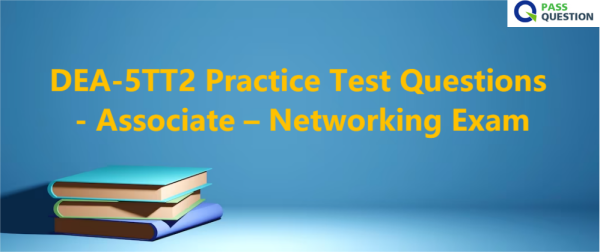DEA-5TT2 Practice Test Questions - Associate – Networking Exam
To help you best prepare for DEA-5TT2 Associate - Networking Exam, practicing with high-quality DEA-5TT2 practice test questions is a great way to prepare yourself. PassQuestion provides a wide range of DEA-5TT2 practice test questions to help you prepare for this exam. These DEA-5TT2 practice test questions are designed to mimic the actual exam, providing you with an opportunity to familiarize yourself with the types of questions you'll be asked and the format of the exam. One of the biggest advantages of using PassQuestion's DEA-5TT2 practice test questions is that they're constantly updated to reflect the latest changes to the exam. This means that you can be confident that the questions you're practicing with are relevant and up-to-date.

DEA-5TT2 Associate – Networking Exam
DEA-5TT2 Associate – Networking Exam is a qualifying exam for the Associate - Networking track. This exam focuses on basic Networking foundational skills and portfolio introduction. The DEA-5TT2 exam is intended for professionals who are new to the networking field or those who want to validate their basic networking skills. It is recommended for IT professionals, network administrators, network engineers, and anyone interested in pursuing a career in networking. The exam consists of 60 questions, and the candidate has 90 minutes to complete it. The exam is available in English, Japanese, Chinese, and Korean. A passing score of at least 60% is required to earn the certification.
DELL EMC DEA-5TT2 Exam Objectives
Network Essentials (5%)
- Explain the purpose and function of network devices such as switches and routers
- Distinguish between interface and cabling options (Copper, Fibre, Breakout)
- Configure and verify the initial configuration steps for a switch
Ethernet Technologies (40%)
- Describe how Ethernet addressing and framing operates (Source learning,Mac address tables)
- Describe the operation and behavior of LLDP, VLANs, STP, LAG (Link Layer Discovery Protocol, Virtual LANs, Spanning-Tree Protocol, Link Aggregation Group)
- Identify the CLI commands to configure and verify LLDP, VLANs, STP, LAG (Link Layer Discovery Protocol, Virtual LANs, Spanning-Tree Protocol, Link
- Aggregation Group)
- Configure and verify common storage networking features (flow control, MTU, Portfast)
IP Networking (25%)
- Identify the differences between private and public IP addressing
- Configure and verify the operation of IPv4 addressing (IP address ranges, subnetting, analyze routing table entries)
- Describe the IPv6 address format and types of IPv6 address
- Explain the forwarding logic used by Layer 3 capable devices
- Identify the differences between static and dynamic routing (connected, static, default routes)
Network Services (5%)
- Identify the CLI commands to configure and verify the operation of DHCP
- Describe the operation and behavior of the NTP service
- Identify the CLI commands to configure and verify the operation of NTP
Security Essentials (10%)
- Describe the options for securing access to a network switch (best practices for interface configuration, VLAN settings, securing spanning tree etc.)
- Configure and verify local authentication
- Configure and verify ACLs (Access Control Lists)
Network Operations (10%)
- Identify the CLI commands to transfer files to/from switches
- Troubleshoot common connectivity problems (link down, VLAN access, IP reachability, Blocked ports)
- Outline the recommended steps during a switch OS upgrade (OS10 update)
- Identify the CLI commands to enable a switch for SNMP monitoring
Automation (5%)
- Explain the role and advantages of using Smart Fabric Services
- Configure and verify the enablement of Smart Fabric Services
View Online Associate – Networking Exam DEA-5TT2 Free Questions
1. What accurately describes the comparison between stacking and VLT?
A.VLT allows for more physical devices to appear as one virtual device than stacking does.
B.Stacked switches share a common control plane while VLT peers maintain their own control plane.
C.Stacked switches and VLT peers allow “single pane of glass” management by maintaining a single control plane.
D.Both VLT and stacking allow devices to use different versions of firmware provided that the switch family/ series is the same.
Answer: B
2. What accurately describes the Simple Network Time Protocol (SNTP)?
A.Time synchronization algorithms are more complex and account for clock drift.
B.Client makes sudden changes in time to keep synchronized.
C.Client synchronizes among a set of distributed time servers.
D.Implemented on a Dell EMC Network OS 9 and OS 10.
Answer: D
3. On Switch A, a static route has been redistributed into OSPF. Which type of OSPF router will this process make Switch A?
A.Autonomous System Boundary Router (ASBR)
B.Designated router (DR)
C.Area Border Router (ABR)
D.Backbone Router (BR)
Answer: A
4. What accurately describes the Network Time Protocol (NTP)?
A.Implemented on a Dell EMC Network OS 6.
B.Time synchronization algorithms do not account for clock drift.
C.Client synchronizes among a set of distributed time servers.
D.Client makes sudden changes in time to keep synchronized.
Answer: C
5. Which fields are mandatory TLVs in a LLDP PDU frame?
A.System Capabilities and Management Address
B.Chassis ID, Port ID, and Time-to-Live
C.IP Address, Default Gateway, and DNS
D.Port Description, System Name, and System Description
Answer: B
6. A network administrator wants to use a subnet that will only have two host addresses. Which subnet mask meets this requirement?
A.255.255.255.248
B.255.255.255.252
C.255.255.255.254
D.255.255.255.256
Answer: B
- TOP 50 Exam Questions
-
Exam
All copyrights reserved 2026 PassQuestion NETWORK CO.,LIMITED. All Rights Reserved.

